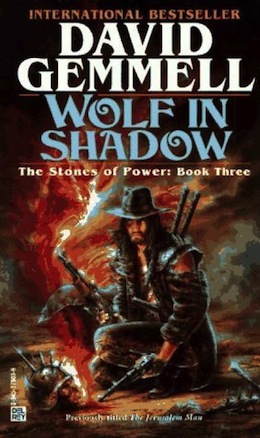Until I met the character of Jon Shannow in David Gemmell’s Wolf In Shadow, I thought of fantasy in terms of black and white, good and evil. Then I discovered the power of grey.
Like many teens of the 1980s, I had read Tolkien and associated fantasy with those characters. Then a mate handed me a copy of Legend and told me to read it. That opened my eyes to how fantasy could be completely different to a full cast of singing elves and dancing dwarves, but then I read Gemmell’s fourth book and really started thinking. Rek, from Legend, a coward who turns baresark, was fascinating. Waylander, a man so destroyed by the loss of his family that he became an assassin, was a character so good that he went on for another two books. But Shannow, who also went for three books, was the one that really made my hair stand on end.
I was absolutely amazed by the way Shannow blew away not just enemies but anyone who crossed his path. There’s a scene where he’s advised to hide his guns away as they are illegal in the approaching town and then the “helper” comes back to rob him—only Shannow has an extra gun hidden in his pocket. Shannow gives him a chance to walk away but, when the man doesn’t believe him, guns him down in an instant. And then he walks away, forgetting about killing someone he admitted was not a “bad man,” because he has done so much of that in the past. The only thing he does regret is killing a boy by mistake.
I found it so fascinating because, up until then, Shannow had only killed “evil” men. In that sense he was more of a traditional hero, albeit one with all sorts of issues! Yet in this one action he turns a bit darker and, I think, even more interesting. It’s not a long scene, nor is it a scene that’s pivotal to the story. Yet it sums up Shannow’s character in a few lines and provides so much power. He can’t afford to have ordinary regrets, only extraordinary ones. He gives the would-be robber one chance. Then kills him. There’s no endless pleading or reasoning. It had to be done. He even offers the robber’s companions money for his horse—then holds onto it when he realises that will prove they are cowards who did not avenge their friend’s death.
It inspired in me a desire to write stories not about pure paladins who only seek to do the right things but conflicted characters who could be evil in some lights. Yes, they have a moral centre (Shannow lives by the Bible, although is very much an Old Testament eye-for-an-eye than a New Testament turn-the-other-cheek guy) but they are hugely conflicted.
I was lucky enough to interview Raymond E. Feist on his Talon Of The Silver Hawk tour, but a huge regret of mine is never getting to meet David Gemmell and having the chance to tell him how Shannow changed the way I looked at fantasy, and heroes. When Australian magazine Books+Publisher compared me to David Gemmell, it was one of the proudest moments in my writing career.
I always seek to create characters who have that edge, who could go either way. In my first series it was Martil, the warrior so despised that he left his own people behind, a man in a dark place who comes back through the love of a small child. In the second series it was Sendatsu, a man so afraid of being his father that he ran away from his responsibilities—until they caught up with him. In the new series it is Fallon, a man who dreams of being a hero, of doing the right thing—but becomes a murderer, a torturer, a liar, a kidnapper, and a thief in order to get his family back. Yes, you can appreciate what he is prepared to do but will you agree with his methods? All of these characters have a common thread – they make mistakes, they have regrets and they don’t always do the right thing. The third of the Shannow books, Bloodstone, was, for me, not the best Gemmell. But if you want to read something dark and gritty with a bitter, confused hero that will grab you and sweep you up, then Wolf In Shadow is compulsory reading.
And if I can make a reader sit up and think, then I feel, as a writer, I have done my job. There is nothing I love more than finding someone who does not usually read fantasy and making them realise that fantasy doesn’t have to be all woodland folk and fairies. While I’m on tour, it is amazing how many people say they don’t read “fantasy” but when I tell them about the books, they discover that it’s something they very much like the sound of. Obviously I also get a lot of pleasure when they later write to me and have enjoyed my books and want to keep reading something gritty and dark, with human characters and moral complexity. And then, of course, I enjoy recommending David Gemmell—and always start with Wolf In Shadow!
Duncan Lay is the author of two best-selling Australian fantasy series, the Dragon Sword Histories and the Empire Of Bones. He writes on the train, to and from his job as production editor of The Sunday Telegraph, Australia’s biggest-selling newspaper. He lives on the Central Coast of NSW with his wife and two children. His latest novel, The Bloody Quarrel, will be released in ebook episodes from Momentum starting this week.










